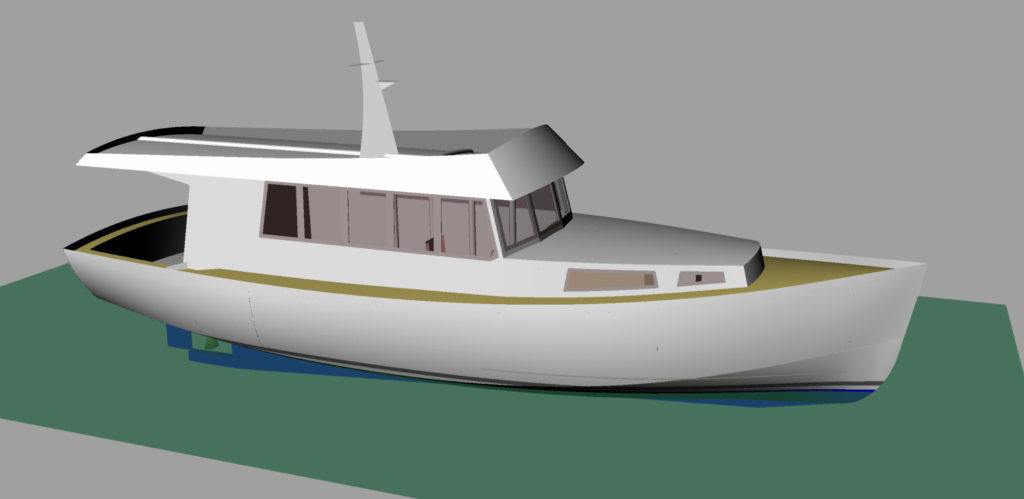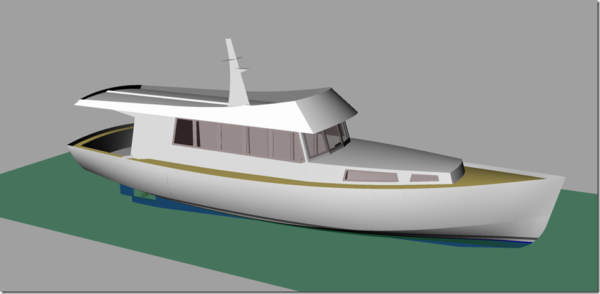Wild South Design: Developments
Wild South 37
The Wild South 37 was designed and built as a concept boat for something that is quite radically different and superior to what the market has to offer. Over the years, a lot of considerations were discussed: larger and smaller vessels, same hull with a different look and appearance, different layouts…
In terms of construction, significant time and effort could be saved if the need for a hull mould was eliminated altogether. While there is nothing wrong with constructing a male plug and building a one-off, a preliminary amount of brainpower has been invested recently into such considerations.
The first option coming to mind is of course building a high-quality hull mould to produce shells. This makes most sense in the context of building finished boats for a local market, otherwise the shells can be cumbersome to transport and prone to damage. However, the hull could also be split into two halves or even also at the chine into four curved pre-manufactured panels that could be joined on the main transverse bulkheads in a record time. Such panels would easily fit within a standard 40′ shipping container and could be transported economically to most destinations. Such approaches require volume to be justifiable.
As for everything, and even more so when it comes to boats, demand is what decides what is worth doing and yacht design is at the thin end of the already very thin new builds market.
Variants
A few years ago, we explored the idea of producing a variant of the design for the European market with river and canal cruising in mind, where excellent economy, shallow draft and the ability to venture out to sea at times would be key assets. This led to an optimised variant using the same hull, but with a steeper stem to keep the overall length below 11.0 metres to reduce berthing costs. The cabin length was extended aft and the roof overhang covered the entire aft deck.

A 36′ variant of the Wild South 37 design with a steeper stem to keep the overall length below 11.0m for European marinas and a covered afterdeck.
The discussion ended when the interested party asked for the roof to be turned into a flybridge and the look of the boat to that of a flush-decked Dashew FPB. Regardless of the questionable aesthetics, the boat was simply too small to offer the headroom forward without a hideous amount of freeboard. The old adage wants that “the client is always right”, but in this case there was no client and the purpose of the initial discussion is ensuring that the outcome sought is aligned with the philosophy of designing boat for the sea first and foremost. In this case, perching up on the roof would have been anything but safe.
Larger Versions
Considering the nautical characteristics of the Wild South 37, the temptation of expanding upwards into a range always existed. The Wild South 37 was designed as a simple, compact, comfortable coastal cruiser. A little more length would make for a more slender hull, better economy around the upper end of the speed range and a faster boat overall while retaining all of the remarkable motion, comfort and stability of the original design. A little more flare in the topsides would increase useable beam while leaving the underwater body largely untouched. A length between 42′ and 46′ (12.5 and 14 metres) should offer enough differentiation from the 37 to warrant designing a new boat.

A 42′ extended version of the Wild South 36/37 hull with a covered afterdeck.
A longer boat based on the Wild South 36/37 hull was sketched and then a variant with a raised pilot house modelled. The latter one is really just a sketch obtained by “breaking” the standard 42′ and lifting the front of the cabin for a look; the aesthetics could benefit from some additional attention.

A preliminary extended version of the Wild South 36/37 hull with a covered afterdeck and stepped wheelhouse. This allows a lateral door to access the side deck from the helm position.
Neither boats had any interior layouts designed. This kind of initial transformative work can be carried out very quickly and efficiently to explore concepts before a design project is even scoped, but it has its limits.
Beyond this, the obvious development path goes towards a long-range, ocean-going motor yacht encompassing the same concepts of very moderate displacement, remarkable seaworthiness through form stability and superb economy arising from an efficient hull without any ballast. Simplicity combined with limited displacement immediately translates into a much more affordable construction cost with unmatched performance and economy afterwards when compared to heavy vessels. Technically, even a 44-footer would be ocean-capable within its range, but a vessel in the 50′ to 60′ length more easily offers such capability, with greater tankage, volume and habitability.


Love your design, how many have been built? Has there been any interest in the longer versions you mention? What would you expect the performance gains to be for the 44′ version?
Graeme,
We built the one in the photos, launched in 2005, then the idea was using it to promote the design etc. It was a very long way from its target market however and the plan slept in my files until last year when I decided to do something with it. Several people tried to buy the finished boat in recent years. In the end it was just too successful in terms of seaworthiness and efficiency not to give it better exposure and I created this site.
There has been a lot of interest from Europe in a slightly modified version at 36′ (just below 11 metres for marinas etc), with a steeper stem, a longer cabin, covered after deck and a slightly lowered profile overall, but nothing done yet. A very capable yard in Poland is interested in building them at a competitive price.
I need to take the time and create a page for it one of these days.
There have been occasional discussions about longer ones, but nothing definitive. A 44′ one would cruise very economically at ~10 knots with a higher top speed again. I also have a few ideas to make them go faster, but I need to do some CFD in this direction before I can say more. It has to do with the aft keel design and the stern sections.
A 44-footer with a little more beam and volume would be a fantastic project and it would give passage-making capabilities together with greater habitability to live on board for long periods.
Best regards,
Eric
Love the design. Been looking for a design that would allow me to cruise at around 8 knots in comfort so as for me to keep pace with several friends who regularly take their sail boats out on adventures to the distant islands of the Philippines where we live. I would be very interested to know more about this design. I also think this design would have a very good potential for the Philippine market. But I think a longer version should provide a better option with its faster and more efficient hull not to mention larger volume for living space.
would this work with twin engines around 40hp each and are there plans to produce hulls for sale.do you have a cost for this hull minus engine thanks. is it possible to change sleeping quarters to make the double a island bed and sill retain 2 bunks? it seems an amazingly economical design that would suit exploring all round NZ and if it was suitable with twin engines making a fair weather crossing to Aus for extended cruising there also.
Hello Peter,
Yes it would work as a twin-screw too and this would make sense for offshore passages. Layout options can be explored, but it depends on the length of the boat. I imagine you are considering something longer than the 11-metre one with 2 x 40HP, because it would otherwise be excessive.
There are no plans to produce hulls. The over-abundance of ridiculously cheap second-hand boats means that only people who want exactly this kind of vessel and can fund a new build are in the market, and this is an extremely thin market.
The best way for you to get a preliminary idea of hull cost would be to show the design to a yard and ask them. We had estimated the cost of building a 36′ in 2014 in Poland at EUR 140Km single engine and fully finished. Labour rates are higher in NZ, but materials should be about the same.
If you become serious about this, please get in touch via e-mail.
Kind regards,
Eric